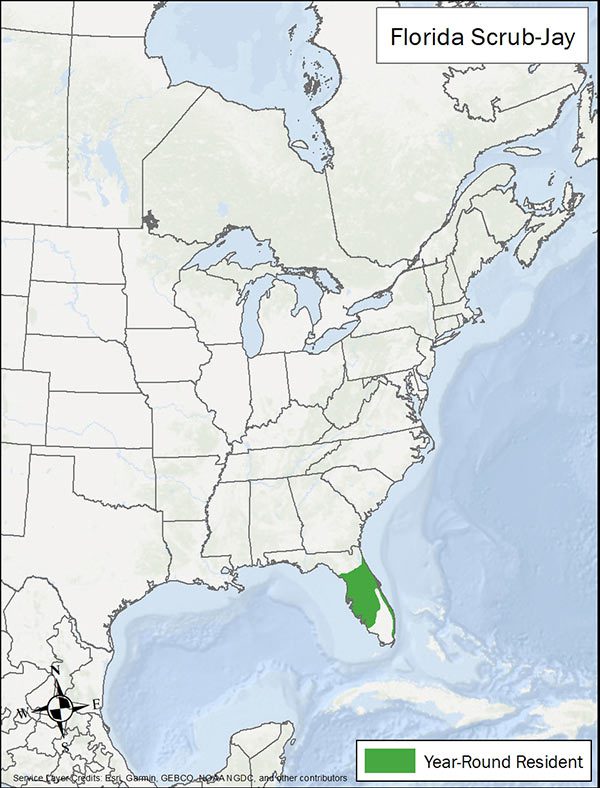LandPKS Learning
Habitat Hub

Florida Scrub-Jay
The Florida scrub-jay is the only bird endemic (found only) to Florida. They are found on some of Florida’s highest and driest parts, ancient sandy ridges running down the middle of the state, old sand dunes along the Atlantic and Gulf coasts, and sandy deposits along interior rivers.
Aphelocoma coerulenscens
Identification
Florida scrub-jay is a large, long-tailed songbird with a sky blue head, wings and tail, approximately 9.1-11 in/23-28 cm long. They have a flat head and heavy bill, pale gray back and belly, with a whitish forehead and neck. Florida scrub-jay family groups have a breeding pair and up to six nonbreeding birds, usually the breeding pair’s older offspring. The helpers assist in raising the young and defending the territory. Florida scrub-jay is listed as a Threatened in the United States.
Observation Tips
Florida scrub-jays hop on the ground in trees and shrubs capturing insects, berries, frogs, toads, snakes, mice and lizards, bird eggs, and harvesting acorns. The Florida scrub-jay buries acorns in the ground for eating later. They perch on wires and exposed branches with the long tail hanging down. Florida scrub-jay are known to occur in the Ocala National Forest and Merritt Island National Wildlife Refuge/Cape Canaveral, Archibald Biological Station, several Florida state parks, state forests, state recreation areas, state preserves, and state reserves.
Interesting Fact
The Florida scrub-jay is the only bird endemic (found only) to Florida. They are found on some of Florida’s highest and driest parts, ancient sandy ridges running down the middle of the state, old sand dunes along the Atlantic and Gulf coasts, and sandy deposits along interior rivers.
Ideal Habitat
Florida scrub-jays are found in sand pine, low-growing, xeric oak scrub and scrubby flatwoods on sandy soils. This sparsely vegetated habitat has a relatively open patchy mosaic of low vegetation with bare sandy patches of fine, white sand with 10-75% bare ground. Oak scrub vegetation is dominated by one or more species of shrubby oaks, including sand live, myrtle, Chapman’s, and scrub oak. Habitat should have scrubby oaks between 3.5-8 ft/1-2.4 m tall. Nests are built from twigs, saw palmetto, and cabbage palm fibers at 3-10 ft/0.9-3 m high in shrubby oaks. The height of vegetation seems to be more important than time since fire for determining the presence of Florida scrub-jay.

Range map provided by BirdLife International
Management Activities that Benefit Species – Best Management Practices (BMPs)
Fire regimes were historically low frequency and high intensity, generally every 8-15 years, dependent on the dominant oak species. If the scrub oak areas have become very dense from fire suppression, mechanical treatment may be required to reestablish fire safely. Minimize soil disturbance when doing mechanical and prescribed fire to reduce the possibility of introducing weeds. Land managers should coordinate on land management practices and strategies so that all appropriate Florida scrub-jay habitat conditions can be established on a larger area that considers the various scrub oak species present. A helpful resource is the Florida Scrub Management Guidelines found here.
Management Activities to Avoid
Avoid habitat destruction and fragmentation from development and conversion to agriculture on these rare sandy habitats. Avoid allowing or using off-road vehicles in scrub oak habitat.
Other Species that Benefit from Similar Habitat Management
Management for Florida scrub-jay benefits many rare and endangered species that rely on oak scrub plant communities, including Florida mouse, Florida scrub lizard, southeastern beach mouse, gopher tortoises, eastern indigo snakes,
Download
Download the Florida Scrub-Jay factsheet
Other Resources
BirdLife International and Handbook of the Birds of the World. 2019. Bird species distribution maps of the world. Version 2019.1. Florida scrub-jay
The Cornell Lab of Ornithology, All About Birds (Florida scrub-jay)
Florida Fish and Wildlife Conservation Commission. Florida scrub-jay
Florida Fish and Wildlife Conservation Commission. Scrub Management Guidelines
NatureServe. 2021. NatureServe Explorer: An online encyclopedia of life [web application]. Version 7.1. NatureServe, Arlington, Virginia. Florida scrub-jay
USFWS. Florida scrub-jay recovery plan
Photo credit: Craig Faulhaber, Florida Wildlife Commission/Flickr
Mobile App | Data Portal | Knowledge Hub | Habitat Hub | Learning Collections | Blog | About | Contact | Support



